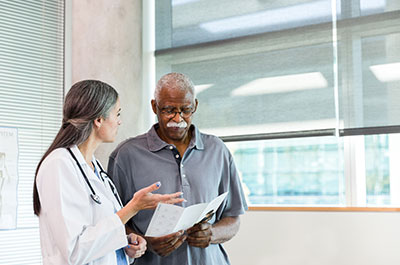While stroke symptoms can vary from person to person, some are more common than others. For example, the acronym F.A.S.T. is commonly used in stroke awareness campaigns – highlighting stroke symptoms such as facial drooping, arm weakness and slurred speech and why time is of the essence when someone is experiencing these symptoms.
However, these aren’t the only symptoms that someone having a stroke might experience. Daniela Danese, RN, a registered nurse and stroke coordinator at Henry Ford Health, highlights other stroke symptoms and how to recognize these changes in a loved one.
Less Common Symptoms Of Stroke
When the brain is impacted by stroke, it is common to experience multiple symptoms at the same time. The biggest thing to remember is that stroke signs are often sudden and persistent – meaning they seem to appear out of no where and don’t go away.
“If someone is experiencing any sudden unusual symptoms related to movement, coordination or cognition, these are all things to pay attention to as possible indicators of a stroke,” says Danese.
In addition to the commonly known stroke symptoms, suddenly developing these symptoms could also be a sign of an ongoing stroke:
- Confusion: This might look like difficulty comprehending speech or trouble understanding simple tasks.
- Vision changes: While many people are quick to attribute blurry vision, seeing double or a temporary loss of vision to fatigue, they could also all be signs of a stroke.
- Balance or coordination issues: Dizziness, trouble walking or vertigo-like symptoms are common in stroke patients.
- A sudden or severe headache: Often described as the worst headache of your life, intense head pain could be a sign of a hemorrhagic stroke. (Remember: Having a stroke isn’t always painless.)
- Nausea or vomiting: Gastrointestinal distress could be a sign of stroke if it occurs without any obvious cause.
- Numbness: Instead of arm weakness or facial drooping, some patients described experiencing a tingling sensation in the face or on one side of the body.
Don’t Delay In Seeking Stroke Care

Stroke is the leading cause of disability in the United States – with one occurring every 40 seconds. And while as many as 80% of cases are preventable through healthy lifestyle modifications, strokes still occur.
Danese offers these tips for responding to someone having these symptoms:
- Don’t ignore symptoms. “Stroke can happen to anyone – regardless of your age or situation,” says Danese. “Never assume that just because you are young and healthy that experiencing unexplained symptoms is something to ignore.”
- Don’t delay calling 911. Even if you aren’t sure if symptoms are related to a stroke, it is always better to get medical insight than to make assumptions. “In stroke care, we always say time is brain because the faster you can seek medical intervention, the better your outcomes,” says Danese.
- Don’t opt for driving someone to the hospital over calling 911. “Calling 911 allows hospital staff to be more prepared to receive a possible stroke patient,” Danese says. “When we are able to get to a patient quickly, we have a better chance of providing clot-busting medications in time to reverse the effects of stroke.”
Not all strokes will present in the same way but being aware of the different symptoms makes it easier to spot and seek care quickly.
Reviewed by Daniela Danese, RN, a stroke coordinator at Henry Ford Hospital in Detroit.



